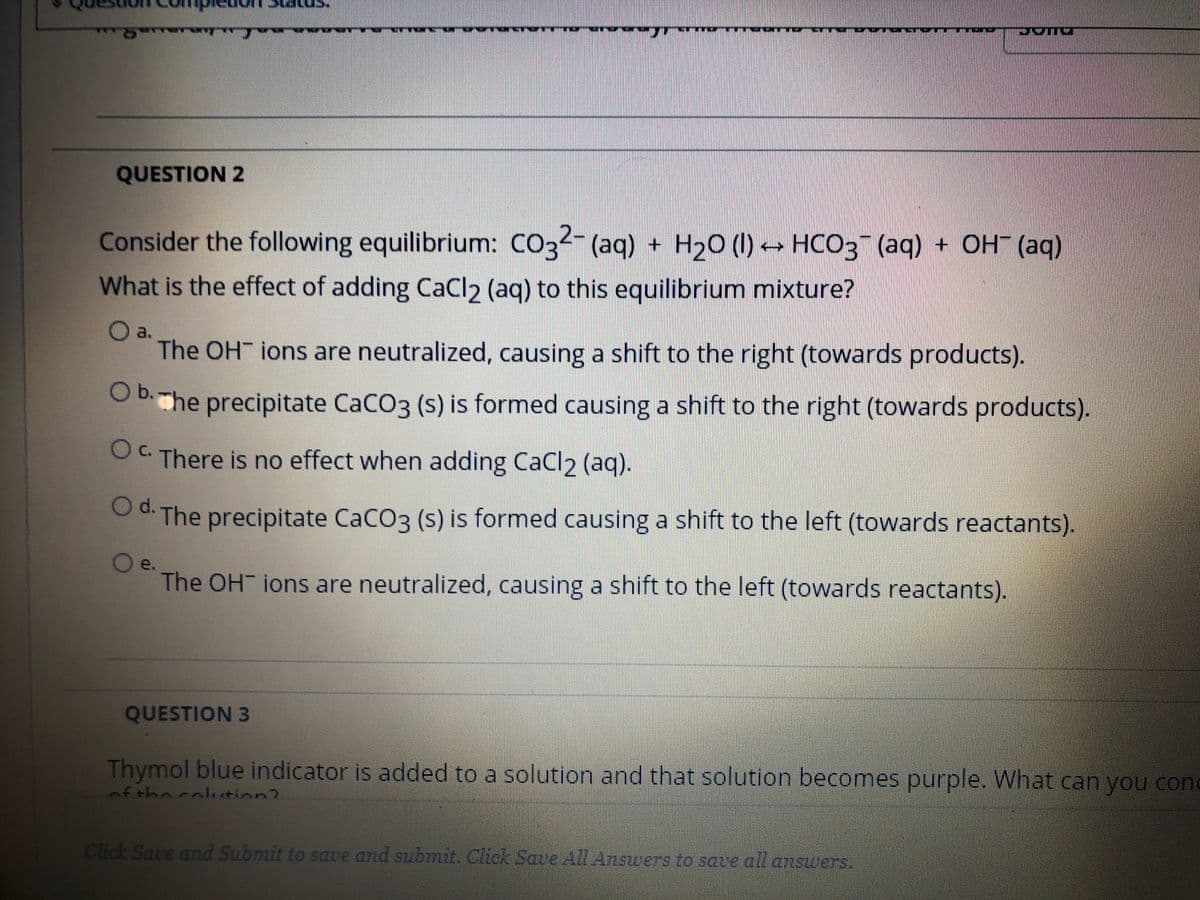QUESTION 2 Consider the following equilibrium: CO32- (aq) + H20 (I) HCO3 (aq) + OH" (aq) What is the effect of adding CaCl2 (aq) to this equilibrium mixture? a. The OH ions are neutralized, causing a shift to the right (towards products). O b.- he precipitate CaCO3 (s) is formed causing a shift to the right (towards products). OC There is no effect when adding CaCl2 (aq). d. O d. The precipitate CaCO3 (s) is formed causing a shift to the left (towards reactants). Oe. The OH ions are neutralized, causing a shift to the left (towards reactants).
QUESTION 2 Consider the following equilibrium: CO32- (aq) + H20 (I) HCO3 (aq) + OH" (aq) What is the effect of adding CaCl2 (aq) to this equilibrium mixture? a. The OH ions are neutralized, causing a shift to the right (towards products). O b.- he precipitate CaCO3 (s) is formed causing a shift to the right (towards products). OC There is no effect when adding CaCl2 (aq). d. O d. The precipitate CaCO3 (s) is formed causing a shift to the left (towards reactants). Oe. The OH ions are neutralized, causing a shift to the left (towards reactants).
Chemistry: The Molecular Science
5th Edition
ISBN:9781285199047
Author:John W. Moore, Conrad L. Stanitski
Publisher:John W. Moore, Conrad L. Stanitski
Chapter12: Chemical Equilibrium
Section: Chapter Questions
Problem 75QRT: Consider the system
4 NH3(g) + 3 O2(g) ⇌ 2 N2(g) + 6 H20(ℓ) ΔrH° = −1530.4 kJ/mol
How will the...
Related questions
Question
100%
Question attached below

Transcribed Image Text:QUESTION 2
ОН (ад)
Consider the following equilibrium: CO32- (aq) + H20 (I) → HCO3 (aq) + OH (aq)
What is the effect of adding CaCl2 (aq) to this equilibrium mixture?
a.
The OH ions are neutralized, causing a shift to the right (towards products).
O Bhe precipitate CaCO3 (s) is formed causing a shift to the right (towards products).
c.
OC There is no effect when adding CaCl2 (aq).
Od. The precipitate CaCO3 (s) is formed causing a shift to the left (towards reactants).
e.
The OH ions are neutralized, causing a shift to the left (towards reactants).
QUESTION 3
Thymol blue indicator is added to a solution and that solution becomes purple. What can you con
nf the coltion?
Click Save and Submit to save and submit. Click Save A7 Answers to sate all answers.
Expert Solution
Step 1
Le Chatelier's principle:
This principle is used to predict the effect of a change in conditions on chemical equilibrium. This principle states that when any system is at equilibrium and if we change in concentration, temperature, or pressure the system changes to a new equilibrium to cancel the change.
Trending now
This is a popular solution!
Step by step
Solved in 4 steps

Knowledge Booster
Learn more about
Need a deep-dive on the concept behind this application? Look no further. Learn more about this topic, chemistry and related others by exploring similar questions and additional content below.Recommended textbooks for you

Chemistry: The Molecular Science
Chemistry
ISBN:
9781285199047
Author:
John W. Moore, Conrad L. Stanitski
Publisher:
Cengage Learning

Chemistry: An Atoms First Approach
Chemistry
ISBN:
9781305079243
Author:
Steven S. Zumdahl, Susan A. Zumdahl
Publisher:
Cengage Learning


Chemistry: The Molecular Science
Chemistry
ISBN:
9781285199047
Author:
John W. Moore, Conrad L. Stanitski
Publisher:
Cengage Learning

Chemistry: An Atoms First Approach
Chemistry
ISBN:
9781305079243
Author:
Steven S. Zumdahl, Susan A. Zumdahl
Publisher:
Cengage Learning


Chemistry
Chemistry
ISBN:
9781305957404
Author:
Steven S. Zumdahl, Susan A. Zumdahl, Donald J. DeCoste
Publisher:
Cengage Learning

Chemistry for Engineering Students
Chemistry
ISBN:
9781337398909
Author:
Lawrence S. Brown, Tom Holme
Publisher:
Cengage Learning

Chemistry: Principles and Reactions
Chemistry
ISBN:
9781305079373
Author:
William L. Masterton, Cecile N. Hurley
Publisher:
Cengage Learning